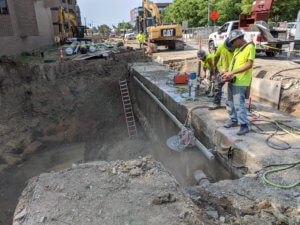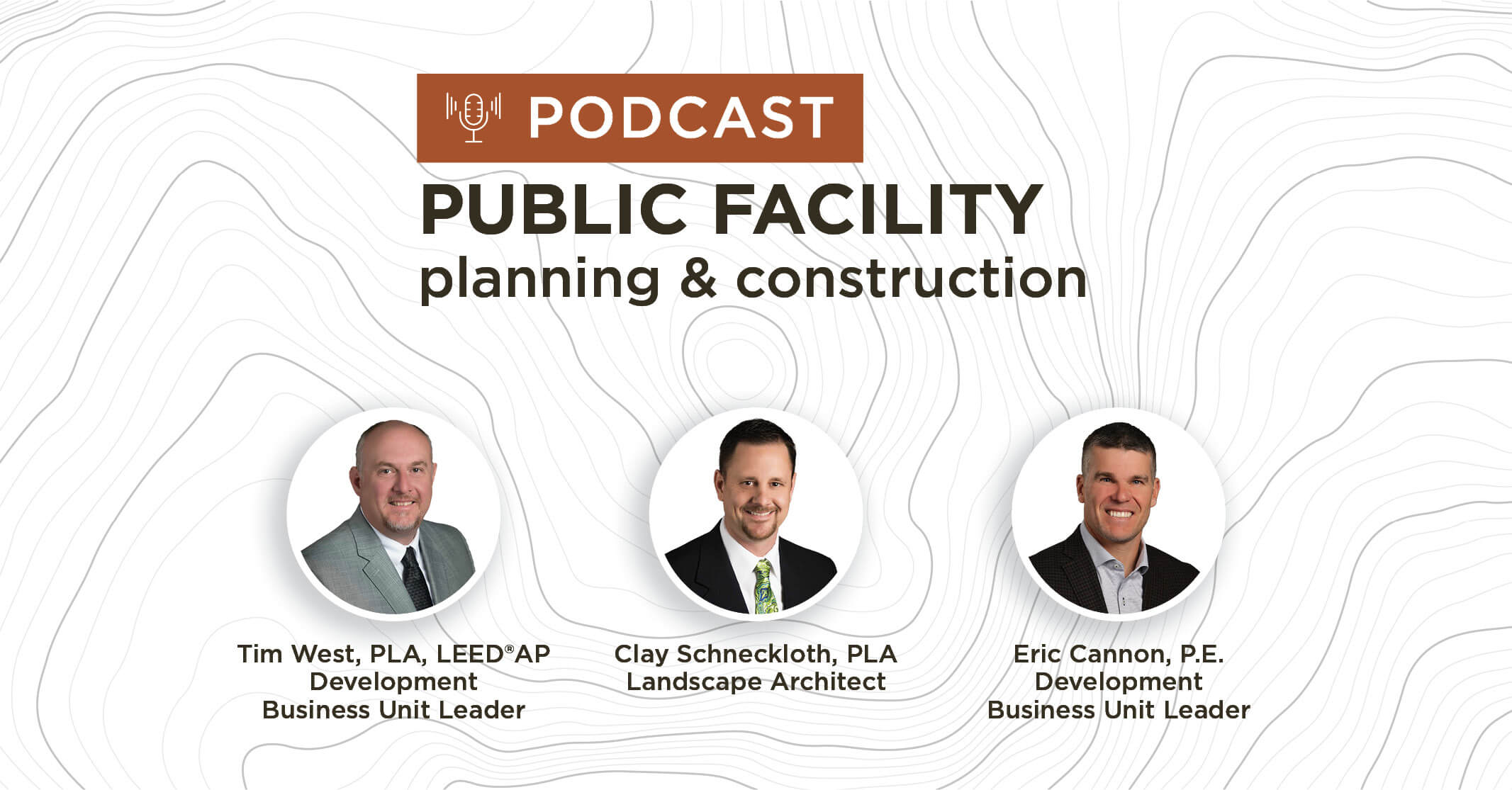Public Bid Facility Project Site Planning & Construction
There is a close relationship between the design and construction process in the site planning for public design projects. Design is the process of creating the description of the new facility and is represented in detailed plans and specifications. Construction makes the design a reality by identifying the required activities and resources to implement the design created by the architect or engineer.
Join a few of our development professionals, Tim West, PLA, LEED AP, Eric Cannon, P.E., and Clay Schneckloth, PLA, as they cover details on the design and construction process for a typical public bid project with an architectural component. They will also discuss tips for navigating the construction phase and share sample building schedules for both six-month and 12-month projects.
Podcast Agenda
- Preliminary Design Phase (1 month) (0:45)
- Design Development Phase (2-3 months) (1:14)
- Understand Soil Quality & Groundwater Table (2:06)
- Construction Documents Phase (2-3 months) (4:20)
- Value Engineering Phase (5:07)
- Bidding Phase (1 month+) (6:01)
- Tips for Scheduling Construction & Site Work (8:07)
- Snyder & Associates Provides Construction Services (11:48)
- Sample 12-Month Building Construction Schedule (13:54)
- Sample 6-Month Building Construction Schedule (14:41)

Tim West, PLA, LEED®AP
Development Business Unit LeaderTim West, PLA, LEED®AP
Development Business Unit LeaderMaster Planning, Project Management, Athletic Design, Park Design, Public Engagement

Clay Schneckloth, PLA
Landscape ArchitectClay Schneckloth, PLA
Landscape ArchitectParks and Recreation Design, Sports Fields Design, Green Infrastructure and Native Plantings, Landscape Design

Eric Cannon, P.E.
Development Business Unit LeaderEric Cannon, P.E.
Development Business Unit LeaderSubdivision and Site Development Engineering, Stormwater Modeling, Master Planning, Municipal Engineering, Construction Assistance
Design and Construction for a Public Bid Project
Tim West (0:19)
Generally, we try to recommend about six months for small or medium projects, and those usually require some form of preliminary design, construction design, and a bid period, which I’ll outline briefly here. But these are pretty standard across most of the projects, wouldn’t you guys agree?
Clay Schneckloth (0:39)
Yeah, we definitely need that amount of time to get through the design process. There are a lot of decisions to be made.
Preliminary Design Phase (1 month)
Tim West (0:45)
The schematic design or preliminary design period can be very quick, around a month timeframe, but that’s where the overall project budget and the overall project schedule are going to be determined. We also start to look at all of the environmental work or geotechnical work, so that phase starts right away. Usually, we’re working with the architect, mechanical, electrical, and structural engineers to determine the overall project package and look at that initial budget.
Design Development Phase (2-3 months)
Preliminary design continues into a design development phase, which also includes the site planning phase. At the tail end of that preliminary design, we usually get to a progress point where we can submit our drawings and our design to a jurisdiction for them to review for a site plan approval. This typically requires building plans and site plans and that will go through the planning and zoning commission and a city council. A cost estimate is also generated at the end of that phase, and that becomes pretty important. Once that’s determined, there’s a construction document phase, which starts to add detail to the project, and that starts to also uncover any type of need for value engineering or modification to the design so that you can have a package that you feel confident with when moving into a bid period.
Understand Soil Quality & Groundwater Table
Eric Cannon (2:06)
Tim, you mentioned the geotechnical engineer involvement. When do you typically see that coming into the fold of the design, and how do you handle poor soils or those factors when it comes to risk and contingencies related to the project?
Tim West (2:22)
We try to get the geotechnical work going as soon as possible. Once we have an understanding of the schematic or preliminary design, we will usually coordinate those soil borings so that we can determine the soil types, what type of groundwater table exists on our site, and to see if there’s any sort of expansive or poor soils that we’re going to have to mitigate.
Once determined that we have some sort of problem, we will usually recommend setting aside some sort of a contingency budget to deal with those problem soil areas. We also can pinpoint the exact location of those based on our progress as we design the project so that we can determine if we need to move the building, parking lot, or something that may allow us to avoid that condition altogether.
We usually have a couple of different geotechnical engineering firms that we like to work with, that we understand how they operate and their schedules, and likewise, they understand how we like to progress through the design so we can include their services in with ours. Typically, we do include them in our contracts so that we can be in control of that work and hit those milestone dates associated with the design schedule.
If you wait until the end of the design schedule, or worse yet, you wait for construction to find out what soils you have, that’s going to cause a lot of problems and potentially slow your project down in the construction phase.
Clay Schneckloth (3:48)
One thing that has come up in the past for me was that I’d like to ask the client or the owner what was in this area previously or some historical information. The geotechnical definitely helps. One time we actually found a footing from an old building that was there before that they just ended up burying onsite. Of course, we didn’t have soil borings every five feet, but those contingencies that you were just talking about come into play at that time.
Tim West (4:15)
And if we know that’s going in, we can accommodate that and work around it. If it’s a surprise in construction, it can really cost a lot of money and, equally important, time. That can be a big delay for the construction project.
Construction Documents Phase (2-3 months)
When we’re doing our cost opinions, we typically include some “what if” bids or construction items in there. So, if we need to add in some additional pavement, if we need to add in some core out excavation and replacement of that area with rock or with good soil, we can get those lined up and estimated and get them onto a bid form so that we have a negotiated bid price on that and not be held hostage on a per-unit price for adding fly ash, or removing and replacing soils, based on a single contractor in the middle of the construction period.
Value Engineering Phase
Clay Schneckloth (5:07)
During construction, I’ve had a scenario where the contractor has brought up an option to value engineer a particular product or piece of the project to help with the contract price a little bit, too. Have you seen that very often?
Tim West (5:22)
We will work with them on that. Typically, we have a value engineering phase at the tail end of our construction document phase as well. We try to identify those areas. The owner may wish to follow our advice, or they may wish to leave it in the bid. A good contractor can help us out with some of those options, too, especially if we have to adjust to something that occurs during construction like a timeframe issue or an unknown condition that wasn’t uncovered in the soil report or some of our surveys starts to become an issue, then we can change the way it’s designed a little bit in construction and maybe reduce the cost of that item by working with the contractor.
Bidding Phase (1 month+)
Once we’re complete with those construction documents and we have a solid cost opinion, we move into a bidding phase, and this is where it gets a little different than some of the other projects that we work on. The public bidding phase requires a number of notifications; it requires a lot of information up front in the bid documents that tell bidders what the rules are on how to submit your bid, where to submit it, and to what conditions and bonding, etc. are required as a part of that.
We usually recommend saving about a month to six weeks to prepare the bid forms, have a bid period for the potential bidders to pull their pricing together, and get those bids opened, read, and approved through an owner or jurisdiction so that we can prepare construction contracts.
From a schematic design phase all the way through the bid phase, we typically recommend six to eight months to complete that work as preliminary work. As you guys have noticed, there are a couple of critical pre-construction items, like the soils, that can go a long way towards eliminating delays during construction that we can spend in that design period.
Eric Cannon (7:10)
The big difference I see here between obviously public projects and private projects is the bidding phase. Because we do have a lot of private development projects with architects where we go through that schematic design development and construction documents, but when we’re working with the public entities, that bidding phase and timeline of meeting all the law and code requirements are really the big difference there.
Tim West (7:31)
Yeah, you’re right, and these types of projects usually don’t end once an amount of site work is completed. Those projects generally have an architectural component in the form of a large building. It might also be a large park construction or something like that that might require some additional time. We continue through a construction phase, which is fairly well regimented and deals with a lot of those same rules so that we can make sure that these projects meet the public bid guidelines and that they’re meeting the specifications and the plans that are set forth as part of that process.
Tips for Scheduling Construction & Site Work
Here are a couple of tips related to that. The building projects generally take about six to 12 months, depending on start dates and depending on how large those buildings are. We try to avoid any scheduling of substantial or critical site work between the months of October and March over the winter months. Sometimes, you’ll get put into a trap where you want to try to get some work done at the very tail end of the year, or you want to start right away in March.
We’ve seen over time that those months are very, very inconsistent for temperatures and rainfall. So, any scheduling that would occur during those months, you want that to either be associated with an enclosed structure or non-critical site work that can be done over a large amount of time, such as maybe some fencing or a playground structure installation, but other parts of that work can’t be done. So, based on that example, you wouldn’t be able to install play surfacing in March or in October, potentially because of nighttime temperatures.
Another thing that we look at when we set our construction schedules is trying not to start the project too early. Grading and utility work usually can’t start until May of any given year. We try to allocate demolition activities and shop drawings for March and April. That gives it a little more of a realistic schedule. If there’s really good weather in March and April, then they can go ahead and move forward with that, but we don’t want to start the project off one or two months behind because we were anticipating better weather than what is historically available in March and April. That also goes for weather delays in the spring and late fall. It’s usually wet through May, and we have some temperature problems, if not rain in October, that starts to reduce the amount of work that we can get done.
Construction Estimates & Budgets
Eric Cannon (9:55)
You mentioned in the bidding phase, receiving bids from contractors. I assume we provide estimates so that the owner has an understanding of roughly where that bid is going to come in. What happens when those bids come in above our estimate or the construction budget that the owner has allocated to the project, and they don’t have the money to build what the low bid has been provided?
Tim West (10:14)
That happens quite frequently when we come in with a construction estimate that’s above their budget. A lot of times, that’s tracked throughout the project, but based on our experience, we’ve seen different bid climates cause higher prices, such as steel prices or cement prices being out of the ordinary.
Bid Alternates
What we typically do is identify a number of bid alternates or items that we discussed with the owner, “It sure would be nice to have this item, but what would be the alternative to building that”? It might be a reduction to an area so that there might be a portion of a parking lot that would be designated as a bid alternate area. If there’s enough money and the bids come in good, they can pick up that extra parking area or maybe the last 10% of the parking. There, likewise, might be some different savings in the style of equipment or levels of service that are associated with a different project, such as we may be able to reduce the number of bleachers in a ball field or we might be able to change the way that an area is configured so that it costs less, that is maybe a different concept than what they wanted.
All of those improvements can be linked into the bid form so that there are some areas where we can reduce the price, or the owner can accept less construction to fit into the budget. That can work in a reverse way, that we can add in wish items that didn’t fit into the budget as we were tracking them during design, but if we get extraordinarily good bids, we may be able to bring those items back into the project.
Snyder & Associates Provides Construction Services

Construction management and observation help ensure the project is going according to plan and help eliminate potentially costly mistakes.
Another area we find is very valuable for the owner is to invest in an informed construction manager. That manager can be us. Snyder and Associates provide a lot of construction services, and we can be there to help with the administration of a job, all the way through being there every day to observe the progress on any given project. The owner can also provide an informed representative on a project that can keep an eye on the progress and on the schedule. That person is pretty important to the construction job, and we would recommend that we have a pretty thorough discussion on who’s going to be that person when construction comes around to maintain those schedules and make sure everything’s getting constructed per the specifications and the plans.
Then the last tip I would offer is to plan ahead and give the contractor as much construction time as possible. In the public bid world, we want to make sure that we’re lining up the working days and the schedule to meet the work that’s associated with those projects and to allow for some weather and rain delay. It’s important to make sure we’re not constricting that schedule too tightly because it will show up on bid day in poor bid prices, and that could cost the project substantially more if we’re trying to get that project done in an unrealistic or less realistic timeframe.
Best Bidding Period
Based on our experience, the best bidding period for these publicly bid projects is usually from late December through February. This gives us the ability to take advantage of contractors usually having a lesser workload, and they can focus on the projects and start to line out the work in the year ahead of them. The second best time to bid on a project is usually in July; that allows for the spring rush to get through for construction, and it allows us to start to plan for a fall grading and foundation package so that the contractor can get a start on the project in the fall, get the building up and enclosed before the winter weather comes in, and they can work on the building over that wintertime when there’s little else we can do on the site construction.
Sample 12-Month Building Construction Schedule
A sample schedule might be as follows for a 12-month building:
- January bid, get approvals done early in the year
- February and March – Shop drawings and demolition
- April – May – Grading in utilities and foundations
- June – Building can start
- Spring of the following year – Finish the building & site work
- June 1st (of the following year) – Targeted completion date
This allows for enough good weather to get seeding down and complete any concrete or pavement installations in the following spring and gives some reasonable timeframe for any bad weather or delays due to a wet season.
Sample 6-Month Building Construction Schedule
A second option would be for a 6-month building, maybe something that’s a little smaller or might be more associated with a private development type of project like an apartment building that might still have some significant design features to it:
- July bid
- August – Demolition and grading
- September – Utility and foundation work
- October, extending over the winter – Building can start
- Spring of the following year – Finish the building & site work
- June 1st (of the following year) – Targeted completion date
There are a lot of different ways that we can assist in outlining a construction schedule. We would just want to meet with you as soon as possible and start laying out your plans for your next project.
